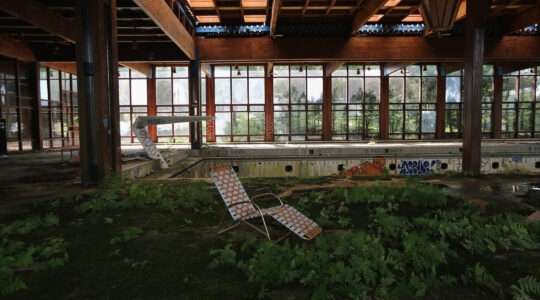Peter Beinart’s recent article “Breaking Faith”[i] in the April issue of The Atlantic traced the collapse of religious culture wars that began in the 1970s in the Christian community, and the resultant disbelief of liberals today who are horrified at the more pernicious racial and national culture wars that have taken their place.
Liberals had correctly predicted that steep declines in formal, organized church affiliation over the past several decades would reduce or eliminate religious morality wars (for example, arguments about gay marriage rooted in “Biblical Scripture”). But what they missed was the possible emergence of other subterranean wars that would follow. Beinart darkly concluded his article by saying, “For years, political commentators dreamed that the culture war over religious morality that began in in the 1960’s and 70’s would fade. It has. And the more secular, more ferociously national and racial culture war that has followed is worse.”
Could involvement in a different kind of faith community… contribute to making America more hospitable to those who are perceived as “other?
Beinart offered several suggestions about the possible humanizing effects on society that greater past participation in church life might have had. We focus on the one we believe he misreads and, as a result, misses a chance to raise a constructive question: Could involvement in a different kind of faith community, one that Beinart excludes from discussion in his article, contribute to making America more hospitable to those who are perceived as “other? Could congregations pave a “third way” between past religious and current national and racial cultural wars?
Although downturns in Jewish congregational participation paralleled those of Christian decline, Beinart omitted any references to these similar Jewish trends. Perhaps it was because the Jewish community was a small player in these morality wars. But moving forward, we believe that the Jewish community should also be included in the question, “Can congregations pave a positive alternative way through past religious and present political cultural wars?”
“Can congregations pave a positive alternative way through past religious and present political cultural wars?”
We offer a qualified “yes.” Our conclusion is based on our recent research of Christian and Jewish congregations and nonprofits that have ties to faith communities that appear in our book, Leading Congregations and Nonprofits in a Connected World: Platforms, People and Purpose. Why? Because of what we heard consistently in approximately 40 interviews with clergy and senior volunteer leaders of Jewish and Protestant congregations and nonprofits with roots in faith communities, and what we know as scholar-practitioners in the Protestant and Jewish communities. Research and experience strongly suggest that congregations can help to heal wounds from the old morality wars, and mitigate the pain of fresh wounds from the current political wars.
Here is a likely clue as to why Beinart does not see this possibility. He writes, “Maybe it’s the values of hierarchy, authority, and tradition that churches” (and we would add, synagogues) “instill. Maybe religion builds habits and networks that help people better weather national traumas, and thus retain their faith that the system works.” This is the most unlikely of Beinart’s explanations for believing that greater past religious participation may hold future promise for a kinder America. Today, on the national level, churches and synagogues have ambivalent relationships with their respective hierarchical bodies and, on the local level, clergy are very aware that people choose to hold beliefs and do not allow beliefs to hold them as a community. One of the most significant changes to religion since the emergence of the Internet is the reduction of intermediaries between the individual and the church or synagogue. This change has made it nearly impossible for faith communities to maintain automatic authority and move their beliefs through their internal, antiquated hierarchical ways of organizing.
Research and experience strongly suggest that congregations can help to heal wounds from the old morality wars, and mitigate the pain of fresh wounds from the current political wars.
The leaders whom we interviewed spoke more about expectations of flatter, more participatory and transparent discussion and decision-making. As a result, we see more congregations shifting from hierarchy as a way of providing organized meaning to less structured social networks as alternatives or complements. They are behaving more like platforms that support diverse social networks. Therefore, if religion cultivates “habits and networks that help people better weather national traumas” it is happening based on something other than “hierarchy, authority, and tradition.”
We learned that “something else” is engagement, and “engagement” does not mean “trying to get more members.” Rather, based on our study of congregations that have shifted or are trying to shift to a culture of engagement, we define engagement as a deep, intentional act of congregations that:
- invite individuals to express and explore their personal spiritual yearnings with unconditional acceptance, but within the framework of a clearly articulated and consistently applied congregational mission.
- connect others with similar spiritual aspirations within their communities with one another.
- engage as congregations with broader networks of faith-based communities and nonprofit organizations.
These three deep dimensions of engagement—between the seeking individual and congregational mission, among individuals within a congregation who share a mission, and across congregations to external networks beyond their particular faith communities, represent a cultural paradigm shift from hierarchies to open, participatory networks. That is why the role of a crisp, inspirational congregational mission becomes so critical. With clarity of mission, that is, when congregations know their purpose and values, they can engage more wisely and easily with a much broader network of other congregations and organizations that top down hierarchies cannot imagine.
Congregations and nonprofits that are shifting to an engagement culture no longer assume that social ties will automatically develop among “members” simply because they “belong” to the same congregation. Rather, they work to ignite social capital between members around an inspirational mission, and then use shared values as bridges to external partnerships that may have even broader impact.
People of faith can and always have lived with paradox. We have “both/and’s” woven into our lives because we see the world both as it is, broken in parts and in need of repair, and beautiful, with a belief that we are called to expand existing pockets of goodness. This paradoxical thinking was clear in our research. The congregations and nonprofits we studied had a clear mission and identity that both grounded them internally and opened themselves up to the world around them. Their posture was generous, curious, and exploratory as they sought to discover avenues where their respective missions could contribute to the common good. Partnerships emerged, often in unexpected places, where the mission and assets of their faith organizations met needs and opportunities around them.
As Christian religious communities internalize implications of acquiring minority status, one that the Jewish community has known, we have new opportunities for learning from and partnering with others. In the process of presenting our work, we have discovered a hunger for expanding current networks of shared learning across our Jewish and Christian communities. Such partnerships can serve the common good of humanity by embodying the shared commitments of our religious traditions that we express in our particular ways. Clarity on mission and a vision for a just world become unstoppable sources of energy and optimism. In today’s world, this happens less from the top down and more from the bottom up. Congregations and nonprofits can create intersections, teach practices, and tell stories of positive change, amplifying and accelerating this work for other sectors of society.
From our work with our respective faith communities, we know that there are many people who are longing for physical and virtual places where they are known, respected, and not narrowly categorized in ways that diminish their multi-faceted selves. They want to participate in today’s diverse society in fruitful, flourishing ways. We know and have studied congregations that care not only about passing on faith to their children, but also about bridging the divides in our world, in helping others live alongside of our neighbors, locally and globally, and advocating for justice. These congregations are making a difference in their communities, and their examples illustrate a generative way forward.
Can involvement in a 21st Century community of faith contribute to making America more hospitable to those who are perceived as “other?” “No,” if these communities are based on 20th century values of hierarchy, authority and tradition.” But “yes,” if they invite people to participate deeply in their missions and engage with their broader communities. Like Beinart, we have our moments of despair. But we are also hopeful, based on what we have heard and seen from many congregations and nonprofit organizations that are pioneering this “third way” forward together out of today’s new culture wars.
Terri Martinson Elton is associate professor of leadership at Luther Seminary. She co-authored Leading Congregations and Nonprofits in a Connected World: Platforms, People, and Purpose with Rabbi Herring, an author and organizational futurist who is CEO of www.hayimherring.com.
[i] retrieved on March 22, 2017 from https://www.theatlantic.com/magazine/archive/2017/04/breaking-faith/517785.
The New York Jewish Week brings you the stories behind the headlines, keeping you connected to Jewish life in New York. Help sustain the reporting you trust by donating today.




